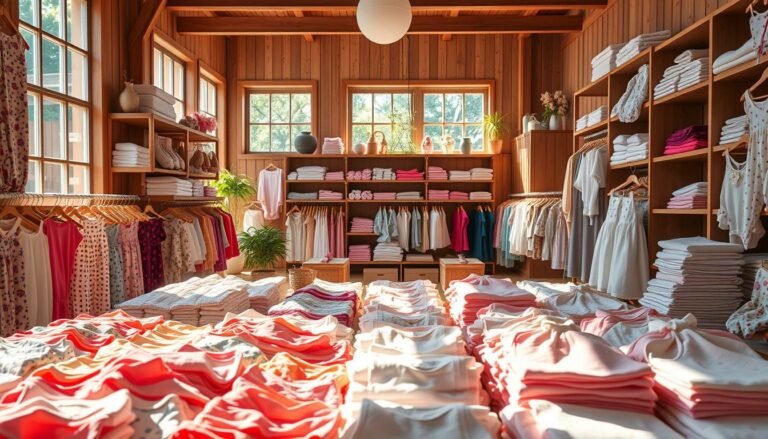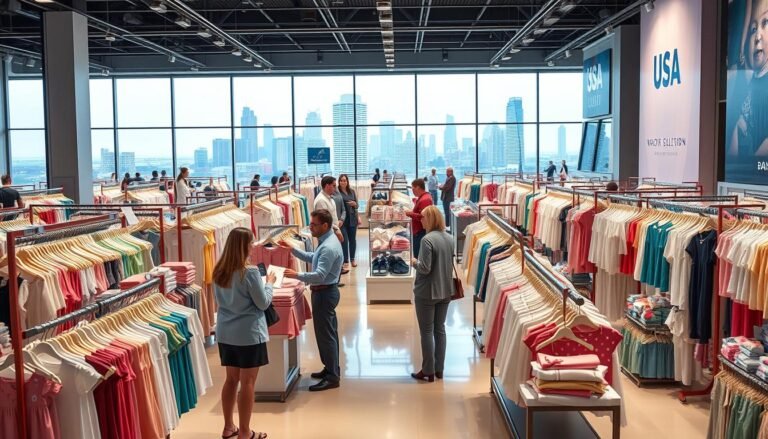Do you find picking baby clothes tricky with so many options out there? Picking the right outfits for your baby girl or boy is more than just about looking good. It’s also about their comfort, safety, and how practical the clothes are. In this guide, we’ll show you how to pick the best baby clothes. We’ll make sure your little one is both cozy and cute.
Key Takeaways
- Understand how to choose the appropriate size for your newborn baby clothes.
- Learn about essential clothing items every baby girl and baby boy needs.
- Find out why fabric choice is crucial for baby clothes.
- Discover how to create a versatile wardrobe for your infant.
- Get tips on selecting outfits for special occasions.
Understanding Baby Clothes Sizes
Finding the right sizes for baby clothes can be hard for new parents. Babies grow fast, and sizes change a lot between brands. It’s key to know about sizes when buying clothes, cheap or expensive, to make sure they fit well.
Newborn Sizes
Newborn sizes are for babies weighing 5 to 8 pounds. But, babies grow out of these fast. It’s smart to buy bigger sizes. Size 0-3 months is good for babies up to 12 pounds, lasting longer. For more help, check out this guide.
0-3 Months and Beyond
As babies grow, they need bigger clothes. Sizes like 3, 6, and 9 months fit as they get bigger. These sizes work for babies weighing 8 to 20 pounds, as they grow. Buying good, cheap clothes in size 0-3 months is a smart move.
Also, European sizes use height in centimeters, which is different. For instance, Size 60 is for babies 12 to 16 pounds or up to 26 inches long. This is like the U.S. size 3-6 months. Knowing this helps you pick the right size.
Essential Baby Clothes for Newborns
Getting ready for your baby means picking the right clothing. It’s important to have the basics for comfort. Also, add some designer baby clothes for big moments. Here’s a list of what you need for your baby’s closet.
Onesies and Bodysuits
Onesies and bodysuits are must-haves. They’re easy to wear and comfy for babies. Choose soft, gentle fabrics to protect your baby’s skin. Having many of these keeps your baby cozy.
Pajamas and Sleepers
Your baby needs warm pajamas for sleep. Get one-piece sleepers that are easy to open for diaper changes. Cute sleepwear makes bedtime routines fun.
Socks and Hats
Babies lose heat through their feet and head. Warm socks and hats are important. They’re needed for outings and cold days too.
Special Occasion Outfits
Comfort is key, even on special days. Include some stylish outfits for events or photos. Ensure these outfits are both cute and comfy.

| Clothing Item | Recommended Quantity | Notes |
|---|---|---|
| Onesies and Bodysuits | 8-12 | Opt for a mix of short and long sleeves |
| Pajamas and Sleepers | 5-7 | Choose breathable fabrics for comfort |
| Socks and Hats | 5-7 each | Ensure they are soft and gentle on the skin |
| Special Occasion Outfits | 2-3 | Select comfortable but stylish designs |
Choosing the Right Fabrics
Picking the right materials for your baby’s clothing is key. It’s all about their comfort and health. Soft and good-quality fabrics are gentle on baby’s skin. Look for organic, airy, and non-allergic fabrics for the best care.
Organic and Hypoallergenic Options
Choosing organic baby clothes keeps harmful chemicals away. Organic cotton is safe because it’s grown naturally. It’s softer and nice for sensitive skin. Hypoallergenic fabrics protect against allergies, perfect for new babies.

Breathable and Comfortable Materials
It’s key to pick comfortable baby clothes that let skin breathe. Natural fibers like cotton, bamboo, and wool are great. They keep moisture away, which helps control body heat and keeps the baby cool. These fabrics make babies happy and calm.
Good fabrics mean comfortable, healthy, and happy babies. They make stylish clothes that feel great.
Mix and Match: Creating a Versatile Newborn Wardrobe
Making a versatile newborn wardrobe is simple. Choose pieces that mix well. This way, babies look cute and stay comfy.
Pick basic onesies and bodysuits in neutral shades or simple designs. They are key for mixing and matching. They work for many occasions and seasons.

Add some pants and leggings for more outfit choices. Choose soft, comfy fabrics. Solid colors and fun prints allow for many combinations.
For variety, add some statement pieces like a patterned jacket or colorful sweater. These can make a basic outfit special for events or outings.
Here is a quick reference table to guide you:
| Item | Quantity | Function |
|---|---|---|
| Onesies/Bodysuits | 5-7 | Everyday wear, easily layered |
| Pants/Leggings | 3-5 | Bottoms for various outfits |
| Sweaters/Jackets | 2-3 | Warmth and style |
| Hats/Socks | Multiple pairs | Accessories and essentials |
Don’t forget hats, socks, and headbands. They add fun to outfits and are very important. They finish the look and protect.
Mix match baby clothes make dressing easy. It saves time and cuts down laundry. It lets parents be creative with a small but smart collection.
Conclusion
When picking the best baby clothes, thinking about comfort, safety, and convenience is key. You should start by knowing the right sizes for your baby. This includes clothes for newborns and infants up to 3 months and older. It’s also wise to know what basics you need. This means having onesies, bodysuits, pajamas, and more to make a good wardrobe.
Choosing the right fabrics is just as important. Go for materials that are organic and won’t irritate your baby’s skin. Clothes that are breathable and comfy are essential. They help keep your baby’s temperature just right and make sure they are cozy day and night. Making smart choices like these ensures your baby stays comfortable.
Learning how to mix and match clothes is a great skill, too. It means you can have a baby wardrobe that is flexible and suited for any occasion. You don’t need tons of clothes, just the right ones. By paying attention to these important tips, you’ll be able to pick the best clothes. Your baby will have everything they need for those first few months.



